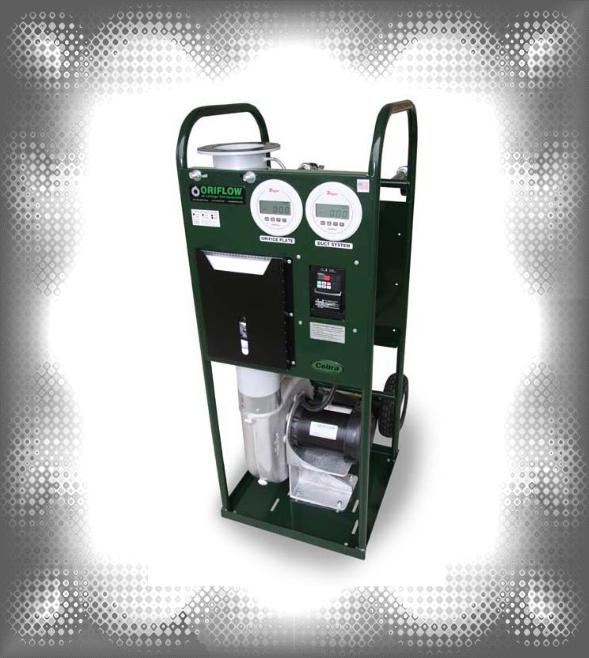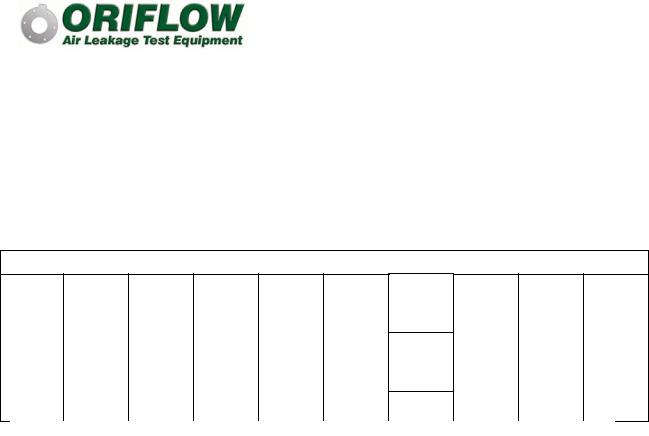Oriflow Lynx, Cobra User Manual

Operating Instructions for
Cobra and Lynx
Duct Leakage Testers (Metric)
© Copyright 2017 ORIFLOW LLC

Table of Contents
Introduction
Introduction ……………………………………….…….. |
2 |
Safety Precautions
Safety Precautions ………………………………….…. |
2 |
Prior to Testing
Are You Using the Correct Tester? …………………… |
3 |
System Preparation …………………….………………. |
3 |
Power Requirements ………………………………….... |
3 |
Extension Cord Requirements ……………………….... |
4 |
Flex-Duct Length ………………………………………... |
4 |
Determining Maximum Allowable Leakage ….……..... |
4 |
Determining Which Orifice Plate to Use …………….... |
5 - 6 |
Duct Leakage Test Setup and Procedure
Install Orifice Plate and Upper Tube Section ………… |
7 - 8 |
Connect Flexible Duct to Orifice Tube ………………... |
9 |
Connect Flexible Duct to Duct System ……………….. |
9 |
System Test Pressure Connection ……………………. |
10 |
Duct Leakage Test Setup (SUPPLY) …………………. |
11 |
Duct Leakage Test Setup (RETURN/EXHAUST) …… |
12 |
Zeroing Pressure Gauges ……………………………… |
13 |
Avoiding Over-Pressurization ………………………….. |
14 |
Obtaining System Test Pressure ……………………… |
15 |
Determining Leakage Rate……………………………… |
15 – 17 |
Troubleshooting
Can’t obtain system test pressure ……………………… |
17 |
Zero reading on “DUCT SYSTEM” gauge ………….... |
18 |
Zero reading on “ORIFICE TUBE” gauge …………….. |
19 |
“ORIFICE TUBE” gauge reading maxed out………...... |
19 |
© Copyright 2018 ORIFLOW LLC |
1 |
Rev: 03/2018 |

Introduction
These operating instructions are for ORIFLOW models COBRA and LYNX air leakage testers. Take pride in knowing that you have purchased the best air leakage tester on the market. It is no secret that Oriflow manufactures the highest quality testers, and has unparalleled customer service and technical support.
The orifice plates available for your duct leakage tester are constructed from lasercut 1.6 mm stainless steel and do not require recalibration for 5 years. Note the authority having jurisdiction may override this requirement, and if so, Oriflow has reasonable rates for re-calibrating orifice plates manufactured by Oriflow.
Safety Precautions
Before operating your tester, read the following safety precautions:
DO NOT operate the tester in the rain,
DO NOT operate the tester while it is near or in water,
DO NOT operate the tester with a damaged electrical cord or plug,
DO NOT remove the inlet safety screen,
DO NOT touch the blower wheel when the unit is plugged in,
DO NOT look into the discharge end of the tester when the unit is plugged in,
DO NOT use the tester as a ladder or step stool,
DO NOT allow children near the tester,
DO use an extension cord of the proper gauge (see Table 2),
DO use the proper voltage and line frequency listed on the motor nameplate,
DO lock the caster when the tester is positioned horizontally,
DO use the tester on level ground,
DO secure the tester when transporting it,
DO wear proper hearing protection, safety glasses and work gloves,
DO seek assistance when lifting the tester (e.g., loading onto truck, going up or down stairs).
© Copyright 2018 ORIFLOW LLC |
2 |
Rev: 03/2018 |

Prior to Testing
Are you Using the Correct Tester?
See Table 1 for the maximum capacity for each duct tester when using the largest orifice plate.
Table 1 – Duct Leakage Tester Capacities
Maximum Leakage Capacity (L/s)*
Model |
250 Pa |
500 Pa. |
1000 Pa |
1500 Pa |
2000 Pa. |
2500 Pa |
3000 Pa |
3500 Pa |
4000 Pa. |
|
|
|
|
|
|
|
|
|
|
Lynx |
260 L/s |
255 L/s |
215 L/s |
110 L/s |
— |
— |
— |
— |
— |
|
|
|
|
|
|
|
|
|
|
Cobra |
310 L/s |
305 L/s |
285 L/s |
220 L/s |
95 L/s |
— |
— |
— |
— |
|
|
|
|
|
|
|
|
|
|
Panther |
635 L/s |
625 L/s |
570 L/s |
505 L/s |
415 L/s |
290 L/s |
125 L/s |
— |
— |
|
|
|
|
|
|
|
|
|
|
Rhino |
770 L/s |
730 L/s |
670 L/s |
630 L/s |
560 L/s |
490 L/s |
420 L/s |
310 L/s |
225 L/s |
* – Using the largest sized orifice available for the model listed.
System Preparation
Cap off all ends of system using clear plastic and duct tape or sheetmetal duct end caps. Make sure you test the part of the duct system that leakage testing is required. Usually, this is from the system fan up to, but not including, the VAV boxes (terminal units). Refer to the engineer's specifications and all applicable codes and test standards.
Power Requirements
Do you have an adequate power supply for your tester (see Table 2)?
Table 2 – Tester Amp Draw
Tester Model |
Voltage |
Flow Control |
Full Load |
|
Option |
Amps |
|||
|
|
|||
|
|
|
|
|
Lynx |
115 |
Slide Gate |
12.7 |
|
|
|
|
|
|
Cobra |
115 |
Slide Gate |
12.8 |
|
|
|
|
|
|
Cobra |
115 |
VFD |
14.0 |
|
|
|
|
|
|
Cobra |
230 |
Slide Gate |
6.4 |
|
|
|
|
|
|
Cobra |
230 |
VFD |
8.0 |
|
|
|
|
|
© Copyright 2018 ORIFLOW LLC |
3 |
Rev: 03/2018 |

Extension Cord Requirements
If you need an extension cord, is it the proper gauge? See Table 3 below for extension cord requirements.
Table 3 – Required Extension Cord Wire Gauge
Tester Model |
Flow Control |
Voltage |
Extension Cord |
Wire Gauge |
|
Option |
Length (meters) |
||||
|
|
|
|||
|
|
|
|
|
|
Lynx or Cobra |
Slide Gate |
115 |
3 to 15 |
14 |
|
15 to 30 |
12 |
||||
|
|
|
|||
Cobra |
Slide Gate |
230 |
3 to 50 |
14 |
|
15 to 30 |
14 |
||||
|
|
|
|||
Cobra |
VFD |
115 |
3 to 50 |
14 |
|
15 to 30 |
12 |
||||
|
|
|
|||
Cobra |
VFD |
230 |
3 to 50 |
14 |
|
15 to 30 |
14 |
||||
|
|
|
Flex-Duct Length
Make sure you have enough flexible-duct with your tester for the job. Each tester includes 3.8 m, which is enough for most applications. Extra lengths of flexible-duct are available at www.oriflow.com/products.
Determining Maximum Allowable Leakage
To determine the maximum allowable leakage for the project, use ORIFLOW’s free online programs to make these calculations (www.oriflow.com/programs).
In the U.S., calculations are done for either of the two typical specifications:
1.Percentage of system flow, or
2.SMACNA Leakage Class.
In Europe, Australia and other countries outside of the U.S., the following specification is commonly used:
1. Pressure Classification (Class A, B, C or D)
If the specification uses SMACNA Leakage Class or Pressure Class, you will need to calculate the total duct system surface area.
Oriflow has FREE Adobe forms available that will calculate duct surface area given the duct shape, dimensions and length (www.oriflow.com/freeform). These forms also calculate Leakage Factor, allowable leakage and Pass/Fail criteria among other calculations.
© Copyright 2018 ORIFLOW LLC |
4 |
Rev: 03/2018 |

Determining Which Orifice Plate to Use
After determining the allowable leakage at the system test pressure, refer to the following tables for the capacities of each orifice plate available for the Cobra and Lynx model testers. The proper plate is the one where the specified allowable leakage falls between the minimum and maximum leakage at the system static pressure.
For example, if you are testing a system at 1000 Pa pressure and the maximum allowable leakage is 165 L/s, you will need a 76 mm orifice plate if using the Cobra tester (see Table 6) or a 102 mm plate if using the Lynx tester (Table 7).
Table 4 – Tester Capacities using the 25 mm Orifice Plate
System Static |
Minimum |
COBRA Tester |
LYNX Tester |
|
Pressure |
Leakage* |
Maximum |
Maximum |
|
Leakage |
||||
(Pa) |
(L/s) |
Leakage (L/s) |
||
(L/s) |
||||
|
|
|
||
|
|
|
|
|
250 |
4.2 |
18 |
15 |
|
500 |
4.2 |
17 |
30 |
|
750 |
4.2 |
16 |
14 |
|
1000 |
4.2 |
14 |
13 |
|
1250 |
4.2 |
12 |
8 |
|
1500 |
4.2 |
10 |
5 |
|
2000 |
4.2 |
4.2 |
-- |
Table 5 – Tester Capacities using the 51 mm Orifice Plate
System Static |
Minimum |
COBRA Tester |
LYNX Tester |
|
Pressure |
Leakage* |
Maximum |
Maximum |
|
Leakage |
||||
(Pa) |
(L/s) |
Leakage (L/s) |
||
(L/s) |
||||
|
|
|
||
|
|
|
|
|
250 |
16 |
73 |
61 |
|
500 |
16 |
71 |
59 |
|
750 |
16 |
68 |
57 |
|
1000 |
16 |
63 |
50 |
|
1250 |
16 |
59 |
40 |
|
1500 |
16 |
47 |
24 |
|
2000 |
16 |
17 |
-- |
© Copyright 2018 ORIFLOW LLC |
5 |
Rev: 03/2018 |
